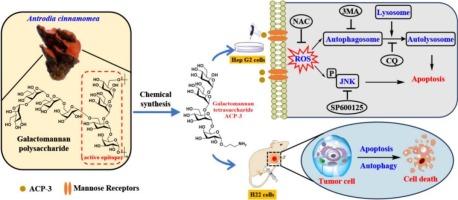半乳甘露聚糖四糖通过ROS/JNK信号诱导的细胞凋亡和ROS介导的自噬依赖性细胞死亡,靶向甘露糖受体抑制肝癌生长
IF 4.7
2区 医学
Q1 BIOCHEMISTRY & MOLECULAR BIOLOGY
引用次数: 0
摘要
肝细胞癌(HCC)是世界上最常见的恶性肿瘤之一。研究表明,从肉桂Antrodia cinnamomea (AC)中提取的多糖具有抗肿瘤活性;然而,迄今为止,AC中与半乳甘露聚糖多糖相关的低聚糖片段的抗肿瘤活性尚未见报道。在这项研究中,我们发现AC半乳甘露聚糖的主干四糖衍生物,被命名为ACP-3,与Hep G2细胞表面的甘露糖受体(MR)特异性结合,促进其细胞内化。因此,这种相互作用通过双重机制引发了有效的抗增殖作用:ROS/JNK信号诱导的细胞凋亡和ROS介导的自噬诱导的细胞死亡。体内研究进一步验证了ACP-3的肿瘤靶向能力,单药治疗可显著抑制H22实体瘤的生长。值得注意的是,ACP-3与环磷酰胺(CTX)合用可协同增强抗肿瘤活性,同时减轻CTX诱导的不良反应,如体重减轻、肝肾毒性和免疫功能障碍。这些发现共同确立了ACP-3作为HCC治疗的有希望的候选药物。本文章由计算机程序翻译,如有差异,请以英文原文为准。

Galactomannan tetrasaccharide targets mannose receptor to suppress hepatocellular carcinoma growth through ROS/JNK signaling-induced apoptosis and ROS-mediated autophagy-dependent cell death
Hepatocellular carcinoma (HCC) is one of the most prevalent malignant tumors worldwide. Studies have documented the antitumor activities of various polysaccharides derived from Antrodia cinnamomea (AC); however, to date, the antitumor activity of the oligosaccharide fragment related to galactomannan polysaccharide in AC remains unreported. In this study, we disclosed that the backbone tetrasaccharide derivative of AC galactomannan, designated as ACP-3, demonstrates specific binding to mannose receptors (MR) on the surface of Hep G2 cells, facilitating its cellular internalization. This interaction thereby elicited potent antiproliferative effects through dual mechanisms: ROS/JNK signaling-induced apoptosis and ROS-mediated autophagy-induced cell death. In vivo studies further validated the tumor-targeting capability of ACP-3, as monotherapy significantly suppresses the growth of H22 solid tumors. Notably, the co-administration of ACP-3 with cyclophosphamide (CTX) could synergistically enhance antitumor activity and concurrently alleviate CTX-induced adverse effects such as weight loss, hepatorenal toxicity, and immune dysfunction. These findings collectively establish ACP-3 as a promising therapeutic candidate for the treatment of HCC.
求助全文
通过发布文献求助,成功后即可免费获取论文全文。
去求助
来源期刊

Bioorganic Chemistry
生物-生化与分子生物学
CiteScore
9.70
自引率
3.90%
发文量
679
审稿时长
31 days
期刊介绍:
Bioorganic Chemistry publishes research that addresses biological questions at the molecular level, using organic chemistry and principles of physical organic chemistry. The scope of the journal covers a range of topics at the organic chemistry-biology interface, including: enzyme catalysis, biotransformation and enzyme inhibition; nucleic acids chemistry; medicinal chemistry; natural product chemistry, natural product synthesis and natural product biosynthesis; antimicrobial agents; lipid and peptide chemistry; biophysical chemistry; biological probes; bio-orthogonal chemistry and biomimetic chemistry.
For manuscripts dealing with synthetic bioactive compounds, the Journal requires that the molecular target of the compounds described must be known, and must be demonstrated experimentally in the manuscript. For studies involving natural products, if the molecular target is unknown, some data beyond simple cell-based toxicity studies to provide insight into the mechanism of action is required. Studies supported by molecular docking are welcome, but must be supported by experimental data. The Journal does not consider manuscripts that are purely theoretical or computational in nature.
The Journal publishes regular articles, short communications and reviews. Reviews are normally invited by Editors or Editorial Board members. Authors of unsolicited reviews should first contact an Editor or Editorial Board member to determine whether the proposed article is within the scope of the Journal.
 求助内容:
求助内容: 应助结果提醒方式:
应助结果提醒方式:


